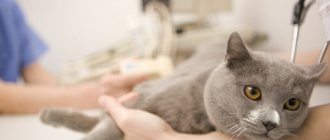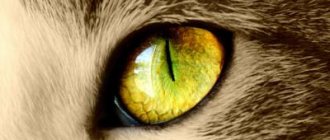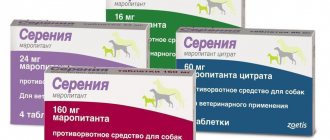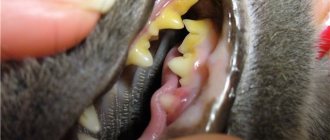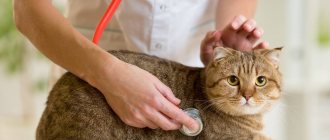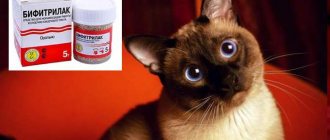Mammary gland
The mammary glands in cats are located in pairs on the stomach and chest. The work of the glands themselves begins during pregnancy, and the main function of the glands is to feed newborn kittens.
The process of milk production is regulated by hormonal processes in the body. Often these processes fail, which ultimately leads to dysfunction of the mammary gland.
Unfortunately, any cat can suffer from mammary disease, whether she has given birth or not. The three most common types of pathologies are:
- Mastitis is inflammation of the gland as a result of accumulation of milk;
- Mastopathy - swelling of the gland and discoloration of the skin around the nipples;
- Cancer is a neoplasm in the tissues of the gland.
In the early stages, it is difficult to distinguish between the symptoms of a particular disease, so if there are signs, the cat should be immediately shown to a veterinarian.
Diagnosis and treatment of mammary cancer in cats
The diagnosis is made based on information obtained from:
- collecting anamnesis (information about the pet’s well-being);
- examination by a veterinarian;
- carrying out blood tests;
- X-ray examination of the chest;
- Ultrasound or CT (computed tomography) of the abdominal cavity.
Ultrasound confirms the presence of a tumor in the cat's mammary gland
If the presence of a tumor in the mammary glands is confirmed, a biopsy is performed - tissue material is taken with a needle and its histological examination under a microscope. This allows us to understand the nature of the growth - malignant or benign. If mammary cancer is confirmed, then the cat will have to undergo either chemotherapy (in the early stages of the pathology) or surgery.
Drug treatment
Drug treatment is performed instead of surgery in the early stages of cancer or after surgery to prevent recurrence and metastasis. The main drugs in animal chemotherapy are:
- Doxorubicin;
- Taxotere;
- Cyclophosphamide.
Cyclophosphamide is an antitumor chemotherapy drug
Anticancer medications are not prescribed to animals in the fourth stage of the disease. The medications will cause large-scale destruction of cancer cells that have grown into surrounding tissues and organs, which will lead to severe necrosis and significantly worsen the condition of the sick cat.
The role of hormone therapy in pet mammary cancer is insignificant, so it is not used as the main method of treatment.
If a cat has a mammary tumor, blood and pus begin to ooze from the wound, and for some reason surgery is impossible, then conservative treatment is resorted to. Applications are made with ointments for purulent-necrotic processes (for example, Levomekol). Antibiotic therapy must be carried out (for example, injections with Ciprovet, Fosprenil). To reduce pain, the animal is given painkillers.
Surgery
Surgical treatment is aimed at complete removal of the tumor. Depending on the prevalence of the process, the following is used:
- spot mastectomy - removal of only one tumor (ineffective, since there is a high risk that cancer cells have penetrated into the surrounding tissue);
- lumpectomy (wide excision) – resection of the tumor along with a small area of surrounding tissue;
- quadrantectomy (segmental excision) - removal of the tumor along with all the tissue surrounding it;
- complete mastectomy - removal of the entire breast.
In case of infiltrative-edematous form of breast cancer (inflammatory carcinoma), operations are not performed (inflamed areas interfere with precise determination of the boundaries of the tumor), only conservative therapy is prescribed. When treating stage 3–4 cancer, surgery must be combined with chemotherapy (it is carried out no later than 4–7 days after tumor resection).
What is the prognosis for recovery?
With timely treatment, when cancer is detected at the initial stage, the probability of no relapses within 3-4 years is high - over 75%. With stage III breast cancer, the life expectancy of animals often does not exceed 4 months.
Modern antitumor drugs can extend the life of an animal after chemotherapy by 5–6 months. After a mastectomy, in half of the cases the pet lives 10–12 months. Treatment of the last stage only reduces the animal’s suffering and leads to an increase in life expectancy by only a couple of months.
Video: how mammary tumors in cats are detected and treated
Causes
The exact cause of cancer in cats, like in humans, has not yet been established. Experts are inclined to say that tumors in pets form as a result of living in cities with poor ecology. There is also an opinion that the animal’s body becomes a victim of cancer as a result of weakened immunity, which occurs due to poor-quality feeding and a reclusive lifestyle.
Another factor: genetics. Predisposition to tumor diseases is inherited, so it is extremely important to study the pedigree of the animal you are going to take into your home.
How to feed kittens with mastitis in a cat
If a nursing cat has been diagnosed with inflammation, then the method of feeding the kittens directly depends on the severity of the disease. If one or two mammary glands are mildly affected, they are bandaged or sealed to limit the babies' access to the affected nipple. If the inflammation has affected all the glands or mastitis develops according to the purulent, hemorrhagic, gangrenous type, then the babies should be isolated from the mother. Milk containing toxic substances can cause poisoning in young kittens.
Types of tumors
Among all cases of tumors in cats, more than 80% are malignant. This type of disease tends to develop very quickly, spreading metastases into the animal’s body almost at lightning speed. Often, compaction occurs in several places at once. The rapid growth of the tumor causes a deterioration in the pet’s condition, which can result in death.
Benign tumors are characterized by slow growth. They are localized in a specific tissue without affecting neighboring organs. In this case, no necrotic processes are observed, which is why the type of disease is called “benign.”
The onset of the disease in both cases is characterized by the same symptoms: a small compaction appears in the cavity of the mammary gland, which does not bother the animal at the initial stage.
Diagnosis of AMF
If you notice any changes in your cat's mammary glands, do not hesitate - make an appointment at the veterinary clinic. Only a specialist can make an accurate diagnosis for your pet.
The first stage of diagnosis is an external examination. Particular attention is paid to the area where the mammary glands are located. The doctor probes each lesion and gland so as not to miss changes. If necessary, a biopsy (examination of cell samples) is prescribed.
Additionally, blood samples are taken for biochemical and clinical analysis. This will allow you to find out how the internal organs function and whether there are accompanying pathological processes in the body.
The next stage of tumor diagnosis is an X-ray examination of the lungs, which allows one to exclude or confirm the presence of metastases in them. If the cancer spreads to the lungs, the cat may have difficulty breathing and develop shortness of breath.
Symptoms
Since cancerous tumors develop very quickly, a timely visit to the veterinarian will allow timely treatment to begin and thereby save the animal. The following symptoms should be the reason to consult a doctor:
- Neoplasms in breast tissue. At the initial stage, the neoplasm resembles a small pea and is easily felt by palpation. It is impossible to determine the type of tumor without examination by a veterinarian. At first, the seal does not cause any discomfort to the cat.
- An increase in tumor size over a short period of time may indicate malignancy. This type of tumor can also appear in the form of a scattering of small compactions, which, as they grow, gather into small clusters.
- As the tumor grows, the cat begins to experience unpleasant sensations: the tumor puts pressure on the tissue. Often at this stage the tumor has already metastasized. It happens that the tumor bursts and opens, taking the form of a bleeding wound. In this case, you need to go to the hospital immediately.
The fate of the pet depends on the speed of the owner’s reaction, so you need to contact a veterinarian as soon as the first symptoms are detected.
Mastitis
Most often, a cat gets mastitis as a result of stagnation of milk in the breast. Another cause may be infection with staphylococcal infection or E. coli. Bacteria also enter the gland through the milk ducts or through the bloodstream.
Mastitis is an inflammation of the cat's breasts. Most often this disease is characterized by symptoms :
- an increase in the size of the gland, swelling, swelling;
- increased cat body temperature;
- redness of the skin of the mammary glands;
- seals may appear;
- blood or pus can be expressed with milk;
- general deterioration in the animal’s well-being, lethargy, apathy.
If mastitis is not treated on time, then in some cases degeneration of the mammary glands may occur, which will lead to the development of tumors, including malignant ones. What should you do if your cat has swollen upper four mammary glands? First of all, it is necessary to take the animal to a veterinarian and examine it for mastitis.
© shutterstock
Stages of cancer in cats
Cancer develops very quickly. The problem is that in the first stages the disease does not manifest itself in any way and does not interfere with the animal’s life. There are several stages of development of a malignant tumor:
- At the first stage, the size of the seals does not exceed one centimeter in diameter. The tumor can be detected by palpation, but the cat itself is not yet bothered by its presence;
- The second stage is characterized by an increase in the tumor up to 3 centimeters. Metastases do not appear at this stage;
- The tumor reaches 5 centimeters in diameter. At this stage, the formation of metastases is possible, which most often affects the lymph nodes located next to the mammary glands;
- The tumor is constantly growing, and metastases reach the liver, lungs and other organs.
Cancer prevention
To reduce the likelihood of developing cancer in your cat, it is necessary to carry out sterilization in a timely manner. The recommended age for a pet is before the animal reaches puberty. At the same time, sterilization does not 100% exclude the appearance of neoplasms.
As soon as the animal reaches the most dangerous age (from 8 years), it is recommended to undergo a thorough examination at a veterinary clinic - at least once every six months. This will allow you to identify the tumor in the initial stages and completely cure your pet.
Proper care, attentive attitude and professional veterinary care are the best prevention of cancer for every cat!
Diagnostics
The only way to determine the presence of a tumor with one hundred percent accuracy is a biopsy. The procedure is carried out very carefully, since tissue injuries can lead to the development of metastases. Along with the examination of the mammary glands, an examination of the lymph nodes is carried out.
Other diagnostic methods are also used for examination: CT, MRI, ultrasound. A blood test is performed to determine the stage of cancer.
Once the diagnosis is confirmed, the animal is prescribed chemotherapy. Biochemistry testing allows you to determine the type of treatment that is appropriate for a particular animal.
Diagnosis of cancer
Detection of even a millimeter thickening should be a reason to contact a specialized clinic. The veterinarian will perform a complete physical examination, paying most attention to the area with growths. The doctor will definitely palpate the lymph nodes: their enlargement may indicate that the process of metastasis has begun.
But to make a final diagnosis, determine the stage and type of the disease, a fine-needle biopsy, cytological examination and a comprehensive blood test (which will allow you to assess the general health of the sick animal) are required. Additional diagnostic tests may include urinalysis and blood clotting time.
Next, you will be given a referral for a computed tomography scan. Only a three-dimensional image will allow you to determine the size, exact localization of the tumor and the presence of metastases. If the process of metastasis is confirmed, then an additional ultrasound examination of the abdominal cavity is performed to detect the affected organs.
Treatment
Treatment of tumor disease in cats is carried out using surgery. A similar procedure is indicated for animals with strong immunity. Weakened and elderly cats may not survive surgery, so therapy for them is limited to medication.
Do not despair if surgery is not indicated for your pet, because modern medicine offers the most powerful drugs to maintain animal health. Conservative treatment has saved many pets around the world.
In the case of a malignant tumor, surgery is the most effective method of combating the disease. The operation removes the affected tissue, which prevents cancer cells from spreading throughout the body. With luck, the surgeon can also eliminate metastases in the lymph nodes, which doubles the chances of recovery.
If the affected areas cannot be removed, the veterinarian decides to remove the mammary glands completely. It is important to understand that such an operation deals a huge blow to the cat’s body. Surgery is often prescribed in combination with chemotherapy.
The operation should only be performed by a qualified specialist. You should only trust the life of an animal to a trusted clinic.
Some owners try to help the cat on their own, which is absolutely not allowed. By self-medicating, you are putting your pet's life in danger!
If the therapy involves taking medications and chemotherapy, it is advised to leave the cat in the clinic. The reason for this: the use of highly toxic drugs that undermine the animal’s immunity. A hospitalized cat's blood is taken daily and its condition is monitored.
What are breast tumors?
Breast tumors can be benign or malignant (cancerous). The second type of breast tumors is distinguished by the ability to metastasize, that is, “capture” neighboring tissues and spread throughout the body through the blood and lymph. Benign tumors are clearly separated from healthy tissues and do not metastasize, but under the influence of factors (malnutrition, taking hormonal drugs, radiation, etc.) they can transform into malignant ones.
It is almost impossible to accurately distinguish a benign tumor from a malignant one based on external symptoms. The nature of the neoplasm is determined through microscopic examination of tissue taken during a biopsy.
Classification of neoplasms
There is a clear classification of breast tumors. Determining the type of tumor is important for drawing up a treatment plan.
Benign neoplasms in the mammary glands of cats:
- adenoma - uniform hyperplasia (growth) of the glandular epithelium in the chest of an animal;
- fibroma - compaction of connective tissue;
- lipoma – a “knot” of adipose tissue;
- fibrolipoma is a tumor of compaction of connective and adipose tissue.
Malignant tumors in the mammary glands of cats:
- carcinoma - uncontrolled cell division of the epithelium of the ducts and alveoli of the mammary glands, accompanied by inflammation of the surrounding tissues;
- mixed tumors - both ductal and epithelial tissues of the mammary glands grow;
- Soft tissue sarcoma is an aggressive type of cancer (its growth is explosive - it begins suddenly and has a progressive rate of spread), and is practically untreatable.
A benign tumor (1) is not prone to metastasis; cells of a malignant tumor (2) tend to “escape” to other organs through the blood or lymph
How to distinguish cancer from mastopathy and other diseases of the mammary glands
The insidiousness of oncology is that its external symptoms are similar to other diseases of the mammary glands. For example, cystic mastopathy (a benign increase in fibrous tissue of the mammary glands) is common in cats. Scientists are inclined to believe that both cancer and mastopathy have the same causes of formation - mainly a deficiency of the hormone progesterone and an excess of estrogen.
Both pathologies are manifested by discomfort in the chest (this can be understood by the fact that the cat does not allow this part of the body to be touched and licks its mammary glands). The appearance of compacted nodules (single and multiple) is possible. Similar signs are also characteristic of mastitis (inflammation of the breast tissue), lactostasis in nursing cats. Only a veterinarian can make an accurate diagnosis after instrumental (ultrasound, CT) and cytological examination.
After operation
An animal that has undergone surgery needs special conditions and careful care. It is important to be able to constantly monitor the pet’s condition, so the owner is advised to stay at home during this period.
Cat after surgery
Before sending home, you need to find out from the veterinarian:
- What food should the animal be fed, as well as the amount of food indicated after surgery;
- How to treat a post-operative scar;
- The schedule for taking medications prescribed by the doctor.
After the operation, the cat is put on a special blanket, which prevents the suture from breaking and protects the wound from contamination.
To treat the sutures, the blanket is removed and returned after the procedure. All this must be done carefully. And if the integrity of the seam is damaged, call a doctor, regardless of the time of day.
Treatment of mastitis
Conservative therapy uses antibiotics and immunocorrective medications. In more severe cases, surgical intervention is resorted to. The duration of treatment for mastitis in a cat is determined by the form of the disease:
- serous - 5-7 days;
- fibrinous - 5-10 days;
- purulent - 14 days;
- gangrenous - 25-30 days;
- hemorrhagic - 10-15 days.
Antibacterial treatment includes cephalosporins (Cefazolin, Cephalexin) or penicillins (Amikacin, Ampicillin). If a fungal infection is added to a bacterial infection, the patient is treated in parallel with antifungal drugs: Griseofulvin, Amphotericin.
When the inflammatory process goes too far, the cat is operated on: the abscessing boils are opened, the purulent contents are removed, and the cavities of the milky lobes are cleaned. In some cases, a partial or complete mastectomy (removal of the breast) is indicated. After surgery, the animal requires a long rehabilitation period.
Anesthesia
If the pain syndrome is severe, the cat is given a novocaine blockade before starting treatment. To do this, an injection is made into the fat layer between the affected area and the peritoneum with a 0.5% or 1% solution of novocaine. The dose depends on the weight of the pet: for every kilogram of weight, take 1 ml of the drug. At the same time, an antibiotic is added to the syringe. Anesthesia is repeated at intervals of two days until the pain symptom completely disappears.
Strengthening the immune system
To strengthen the body's defenses, the cat is prescribed complex dietary supplements. Vitamins and minerals support the immune system and help quickly neutralize the inflammatory focus. The vitamin preparation is fed to the animal for two months. Immunomodulators also provide support: Neoferon, Globfel, Catozal and others. The immunoglobulins and plant extracts they contain stimulate your own immunity.
Treatment of congestive form
If stagnation of milk is noted, it is necessary to carry out procedures to stimulate its outflow. Diuretics are prescribed among medications. They promote faster removal of fluid from the body, thereby slightly reducing the flow of water into the mammary glands.
global $ads_google; //data-ad-slot=”2475549904″ $ads_google = empty($ads_google) ? false : true; ?> if ($ads_google == false) {?>
$ads_google = true; ?> } ?>
Treatment of stagnant mastitis includes antiseptic compresses made from Chlorhexidine. The solution is heated to body temperature, a sterile gauze cloth is moistened in it, lightly squeezed and applied to the sore spot. Cover the compress with polyethylene and bandage it. Keep the bandage on for 10-15 minutes. An alternative to Chlorhexidine can be ichthyol or chloramphenicol ointment, infusions of medicinal herbs with an antibacterial effect.
Prevention
There is no exact cause of mammary tumors in cats. However, it is reliably known what preventative measures pets need:
- Proper nutrition . You need to feed your cat high-quality food or natural products. You should avoid cheap food, as well as table food. Murks rarely refuse “harmful” treats, but the owner must understand that the responsibility for the pet’s health lies with him.
- Quality care . Keeping an animal includes not only feeding, but also regular visits to the veterinarian, even if the pet is apparently healthy. It would also be a good idea to examine the animal at home. If you feel unwell, you should consult a doctor and not self-medicate.
- Sterilization , if the animal does not participate in procreation. This procedure significantly reduces the risk of tumors and completely eliminates the possibility of developing malignant tumors. In the absence of sexual activity for a long time, unsterilized animals are at risk.
- Abstinence from treatment with hormonal drugs. Such drugs cause enormous harm to the body, often leading to disastrous consequences.
- Timely medical assistance for any kind of ailment. This is especially true for diseases of the genitourinary system, as well as mastitis.
Quality care is the best prevention
A mammary tumor in a cat is a serious disease that requires immediate medical intervention. Timely diagnosis and assistance will help save your pet's life.
If you have any questions, you can ask us in the comments section.
Treatment methods
Just a few years ago, the discovery of a malignant tumor in a pet meant a death sentence. But thanks to recent advances in veterinary medicine, cancer is no longer a "head for euthanasia." Treatment for mammary cancer in cats depends on the location, type and stage of tumor development. The good news is that in the early stages of the disease (if a well-differentiated tumor without metastasis has been identified), the survival rate is more than 85%.
Surgical intervention
Surgery is the main method of treating breast cancer. The type of intervention is determined according to the results of diagnostic studies. If the malignant tumor is small in size and has clearly defined boundaries, then organ-sparing surgery is performed: lumpectomy. In this case, only the tumor itself is removed. In the diffuse form of the disease (when the tumor grows not only in the mucous layer, but also in the muscle layer), the entire package of mammary glands is removed. At later stages, when malignant cells spread to surrounding tissues and lymph nodes, the following types of operations may be prescribed:
- unilateral mastectomy (all glands and regional lymph nodes on the affected side are removed);
- bilateral mastectomy (removal of paired glands);
- radical mastectomy (removal of all mammary glands, including nearby lymph nodes).
If the cancer is actively metastatic, the surgeon may additionally remove distant lymph nodes (often inguinal and axillary), based on already known routes of lymphatic drainage.
Many owners worry that the animal will not be able to lead a full life after such an operation. Despite the fact that the procedure is quite aggressive, with a successful outcome there is an almost 90% guarantee of no relapse.
Chemotherapy
If surgery to remove mammary cancer in cats is not possible for certain reasons (for example, due to extensive metastasis, heart and blood diseases), then chemotherapy is prescribed. A course of aggressive medications is unlikely to completely remove the malignant tumor, but it will help the pet live for several more years. Chemotherapy may also be recommended to remove metastases, especially for those animals that have successfully undergone surgery to remove the tumor.
There is no need to worry that your furry pet will become completely bald after chemotherapy. Unlike people, who actually lose their hair after a similar procedure, animals keep their fur coat.
Chemotherapy must be carried out by a veterinarian in a specialized medical center. You need to prepare for the fact that for some time after chemotherapy is completed, your pet will constantly sleep and refuse food.
Radiation therapy
Radiation therapy is rarely the first choice for the treatment of cancer in veterinary medicine. Radiation is prescribed if surgery and chemotherapy do not work or are contraindicated.
The technique is quite effective, but specialized veterinary equipment is available only in very large cities. To achieve a positive result, you will need at least three sessions with a break of several days. But the final radiation program is developed by a veterinary radiologist, based on the results of diagnostic tests and medical history.
What does a veterinarian do when a cat has mastitis?
The doctor develops a treatment regimen based on the general condition of the sick pet, the form of feline mastitis and the severity of the pathological process. Standard diagnostic methods are shown:
- general blood analysis;
- bacteriological analysis of the secretion that comes out of the nipples;
- Ultrasound of the mammary glands.
Treatment involves the use of the following means:
- novocaine blockade (in the presence of severe pain);
- antimicrobials;
- antibiotics;
- vitamins;
- immunostimulants.
Cat undergoing professional examination
Compresses and massage are recommended for a sick animal. In the presence of a purulent inflammatory process, surgical intervention is indicated.
Features of the course and treatment of mastitis in pregnant cats
Mastitis affects not only nursing cats, but also pregnant animals. During pregnancy, animals may experience the following types of disease:
- lactation - occurs due to hormonal imbalance or premature milk release;
- non-lactational - appears against the background of a weakened or complete absence of immunity associated with physiological characteristics during gestation, as well as as a result of injury.
When the first signs of mastitis appear in a nulliparous cat, even with the slightest suspicion of the presence of the disease, the pregnant female should be taken to the veterinarian. Otherwise, serious complications are possible that can affect not only the offspring, but also the quality of life of the pet.
The initial stages of mastitis in pregnant cats are best treated with topical medications and folk remedies, with the main point being proper care. If the disease has reached a purulent form, antibacterial therapy and surgical intervention are indicated. With mastitis of the lactation type, it is important to regularly and promptly express milk from the cat’s hard glands until the offspring are born.
Important! If there is bloody or purulent discharge, it is necessary to regularly wipe the glands with a cotton pad soaked in hydrogen peroxide or chlorhexidine.
Causes of seals
The main reasons that lead to the appearance of swelling can be identified:
- Negative effects on the animal’s body from excessive environmental pollution;
- Unbalanced diet, presence of low-quality food in the diet;
- Hereditary predisposition to the development of pathologies;
Often the reason why a cat has swollen mammary glands after kittens lies in the early separation of the offspring from the mother. Most often, this condition does not have a negative effect on the pet’s body and goes away on its own over time. In this case, it is recommended to express milk both independently and with the help of a veterinarian. You can also make lotions at room temperature from a decoction of oak bark or chamomile.
Disease prevention
In order to protect your animal from illness, a number of rules should be followed:
- eliminate rapid flow of milk;
- control the pet’s feeding schedule;
- Regularly clean the cat and kittens’ resting place, wash the bed and other accessories, and ensure high-quality hygiene;
- do not allow the feline to be in the cold and drafts;
- constantly examine the female during the period of feeding kittens, pay attention to stagnation of milk in the cat, external damage, neoplasms, discharge and other suspicious signs;
- care for your pet’s nipples during pregnancy and after birth;
- wipe the mammary glands with a weak solution of potassium permanganate when even the smallest scratches appear;
- sterilize your cat only in trusted veterinary clinics;
- prevent contact of a nursing cat with sick animals;
- follow the schedule of vaccinations, treatment against skin parasites and helminths (step-by-step instructions are given by the veterinarian during a routine examination).
Mastitis in a nursing cat can be completely cured without any complications. The owner must carefully monitor the animal in order to notice pathological changes in time. It is important to keep your pet in suitable conditions, provide it with warmth and hygienic care.
Video
